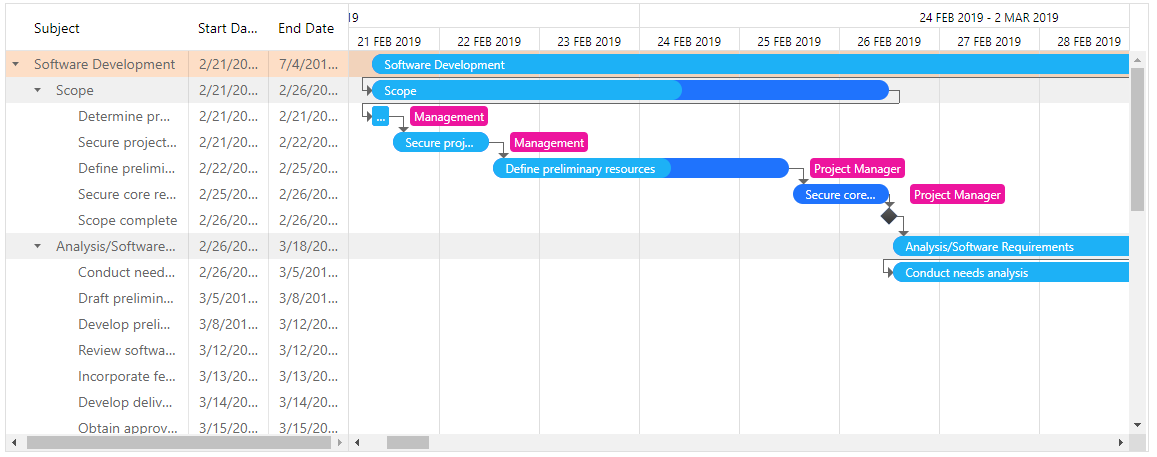ASPxGantt Class
A Gantt control.
Namespace: DevExpress.Web.ASPxGantt
Assembly: DevExpress.Web.ASPxTreeList.v19.1.dll
Declaration
Related API Members
The following members return ASPxGantt objects:
Remarks
The ASPxGantt allows you to display the task flow and dependencies between tasks.

Create a Gantt Control
Design Time
The ASPxGantt control is available on the DX.19.1: Data & Analytics toolbox tab in the Microsoft Visual Studio IDE.
Drag the control onto a form and customize control settings, or paste the control markup in the page’s source code.
<dx:ASPxGantt ID="Gantt" runat="server" Width="60%"
KeyFieldName="ID" ParentFieldName="ParentID"
TasksDataSourceID="TasksDataSource"
DependenciesDataSourceID="DependenciesDataSource"
ResourcesDataSourceID="ResourcesDataSource"
ResourceAssignmentsDataSourceID="ResourceAssignmentsDataSource">
<Columns>
...
</Columns>
<Mappings>
<Task ID="ID" ParentID="ParentID" Title="Subject" Start="StartDate" End="EndDate" Progress="PercentComplete" />
<Dependency ID="ID" PredecessorID="ParentID" SuccessorID="DependentID" DependencyType="Type" />
<Resource ID="ID" Name="Name" />
<ResourceAssignment ID="ID" TaskID="TaskID" ResourceID="ResourceID" />
</Mappings>
...
</dx:ASPxGantt>
Run Time
protected void Page_Init() {
ASPxGantt gantt = new ASPxGantt();
gantt.ID = "ASPxGantt1";
form1.Controls.Add(gantt);
gantt.TasksDataSourceID = "TasksDataSource";
gantt.DependenciesDataSourceID = "DependenciesDataSource";
gantt.ResourcesDataSourceID = "ResourcesDataSource";
gantt.ResourceAssignmentsDataSourceID = "ResourceAssignmentsDataSource";
gantt.Columns.Add(new GanttColumn("Subject"));
gantt.Columns.Add(new GanttColumn("Start"));
gantt.Columns.Add(new GanttColumn("End"));
gantt.Mappings.Task.ID = "ID";
gantt.Mappings.Task.Title = "Subject";
gantt.Mappings.Task.ParentID = "ParentID";
gantt.Mappings.Task.Start = "StartDate";
gantt.Mappings.Task.End = "EndDate";
gantt.Mappings.Task.Progress = "PercentComplete";
gantt.Mappings.Dependency.ID = "ID";
gantt.Mappings.Dependency.PredecessorID = "ParentID";
gantt.Mappings.Dependency.SuccessorID = "DependentID";
gantt.Mappings.Dependency.DependencyType = "Type";
gantt.Mappings.Resource.ID = "ID";
gantt.Mappings.Resource.Name = "Name";
gantt.Mappings.ResourceAssignment.ID = "ID";
gantt.Mappings.ResourceAssignment.TaskID = "TaskID";
gantt.Mappings.ResourceAssignment.ResourceID = "TeamID";
gantt.DataBind();
}
Features
Data-Bound Mode
The Gantt control can operate only in bound mode. It supports standard data source types including SqlDataSource, ObjectDataSource, XmlDataSource, AccessDataSource, and SiteMapDataSource.
<dx:ASPxGantt ID="Gantt" runat="server" Width="100%" ClientInstanceName="clientGantt"
KeyFieldName="ID" ParentFieldName="ParentID"
TasksDataSourceID="TasksDataSource"
DependenciesDataSourceID="DependenciesDataSource"
ResourcesDataSourceID="ResourcesDataSource"
ResourceAssignmentsDataSourceID="ResourceAssignmentsDataSource">
...
</dx:ASPxGantt>
<asp:SqlDataSource ID="TasksDataSource" runat="server"
ConnectionString='<%$ ConnectionStrings:DevelopmentGanttConnectionString %>'
SelectCommand="SELECT * FROM [Tasks]" />
<asp:SqlDataSource ID="DependenciesDataSource" runat="server"
ConnectionString='<%$ ConnectionStrings:DevelopmentGanttConnectionString %>'
SelectCommand="SELECT * FROM [TaskDependecies]" />
<asp:SqlDataSource ID="ResourcesDataSource" runat="server"
ConnectionString='<%$ ConnectionStrings:DevelopmentGanttConnectionString %>'
SelectCommand="SELECT * FROM [Teams]" />
<asp:SqlDataSource ID="ResourceAssignmentsDataSource" runat="server"
ConnectionString='<%$ ConnectionStrings:DevelopmentGanttConnectionString %>'
SelectCommand="SELECT * FROM [TaskTeamRelations]" />
View Types
The Gantt control can use the following views to display tasks: hours, days, weeks, months.
Custom Worktime
You can specify the work and non-work time intervals, as well as custom workdays and holidays.
The work time settings are stored in the WorkTimeRules collection. The following rules are available:
Each rule can contain work time ranges and recurrence settings.
<dx:ASPxGantt ID="Gantt" runat="server" Width="100%" ClientInstanceName="clientGantt" ...>
...
<WorkTimeRules>
<dx:DailyRule>
<WorkTimeRanges>
<dx:WorkTimeRange Start="08:00" End="11:55" />
<dx:WorkTimeRange Start="13:00" End="17:00" />
</WorkTimeRanges>
</dx:DailyRule>
<dx:WeeklyRule IsWorkDay="false">
<Recurrence DayOfWeek="Saturday" />
</dx:WeeklyRule>
<dx:WeeklyRule IsWorkDay="false">
<Recurrence DayOfWeek="Sunday" />
</dx:WeeklyRule>
<dx:YearlyRule IsWorkDay="false">
<Recurrence Day="27" Month="May" />
</dx:YearlyRule>
<dx:YearlyRule IsWorkDay="false">
<Recurrence Day="14" Month="February" />
</dx:YearlyRule>
<dx:YearlyRule IsWorkDay="false">
<Recurrence Day="8" Month="March" />
</dx:YearlyRule>
</WorkTimeRules>
</dx:ASPxGantt>
Scrollable area
You can scroll the TreeList and Gantt areas to view all the tasks.
Task title position
You can hide a task title or display it inside or near the task.
Resources
You can specify resources for tasks.